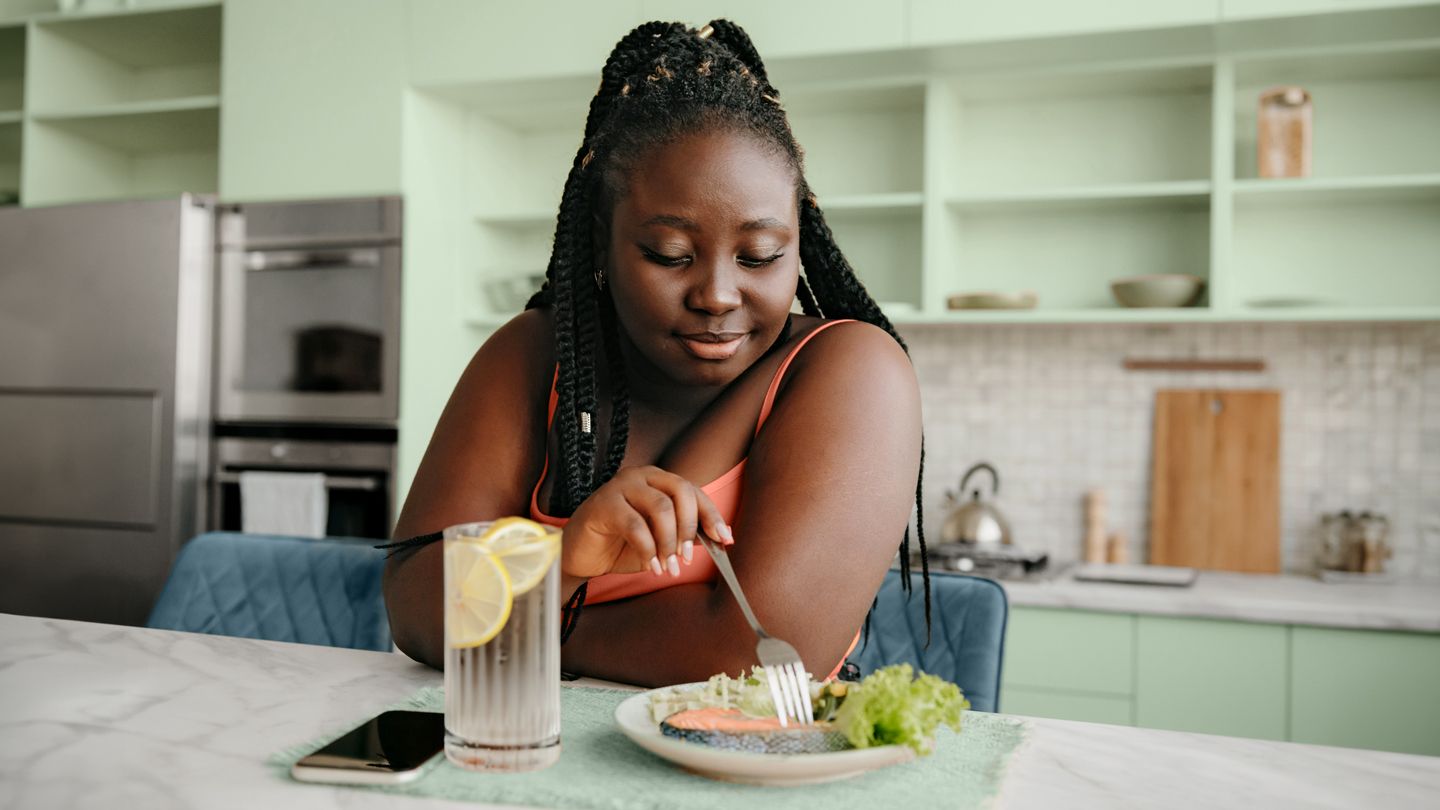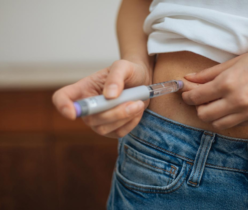Eating well and exercising are the keys to weight loss if you have type 2 diabetes, but building these habits can be hard. These strategies can jump-start your journey to a healthy weight.
Excess weight when you have type 2 diabetes can make it more difficult to manage your condition. “The additional weight adds to the insulin resistance, making it hard for your body’s natural insulin to do its job,” says Vandana Sheth, RDN, CDCES, a spokesperson for the Academy of Nutrition and Dietetics who is based in Torrance, California.
Losing even a few pounds offers big benefits. Weight loss can help keep A1C levels below 7, which is a common target number for most adults, according to a study. A1C is a two- to three-month average of blood sugar levels, according to the American Diabetes Association (ADA).
RELATED: 5 Ways to Lower Your A1C
Simple changes in the way you eat can make a big difference. For example, packing healthy snacks like nuts that you can easily grab during the day can help steer you away from the vending machine.
Plan your meals and follow a smart pattern of eating to set yourself up for success.
The Mediterranean diet, for example, is linked to improved blood sugar levels, lower heart risks, better liver function, and other benefits, according to research. And a cohort study of almost 100,000 subjects over time showed those who ate more plant-based diets had up to a 34 percent reduced incidence of type 2 diabetes.
Also, don’t discount the importance of regular exercise. For people with type 2 diabetes, physical activity can reduce blood pressure, improve heart health, stabilize blood sugar, and boost overall quality of life, according to other research.
RELATED: 7 Ways to Stay Motivated to Exercise When You Have Type 2 Diabetes
Here are some other tips to jump-start your weight loss journey.
According to research, study participants who ate from larger plates often perceived portion sizes as being smaller than they really were, while a smaller plate that was filled up could make people think they were actually eating more than they were. For diabetes weight loss, opt for smaller plates (such as salad plates) and bowls to help you eat less and feel more satisfied, Sheth says. And if you haven’t already, it’s also good to speak with a certified diabetes care and education specialist (CDCES) or a registered dietitian-nutritionist (RDN) to learn about proper portion sizes.
RELATED: The Best and Worst Foods to Eat in a Type 2 Diabetes Diet
Writing down what you eat can make it easier to track and control what you’re putting into your body. In fact, a yearlong study found that people with type 2 diabetes who consistently (about 66 percent or more of the time) wrote down what they ate lost an average of about 10 pounds (lbs) over the study period compared with the control group, which did not experience significant weight loss.
Keeping a food log is especially good for assessing the amount of carbohydrates you’re eating, says Jessica Crandall Snyder, RDN, CDCES, the CEO of VitalRD in Englewood, Colorado.
A single serving of carbs is 15 grams (g), according to the Centers for Disease Control and Prevention (CDC). The agency recommends that most women with diabetes get three to four carb servings, equaling 45 to 60 g, per meal. Meanwhile, the CDC recommends most men with the disease aim for four to five carb servings, or 60 to 75 g.
Nonetheless, there’s no one-size-fits-all carb recommendation. An RDN or CDCES can help you understand the number of carbs in different types of food you eat, and the best carbohydrate goals to meet your personal needs.
RELATED: How to Avoid Blood Sugar Highs and Lows if You Have Type 2 Diabetes
You know you need to exercise to lose weight, but keep in mind that finding small ways to be active throughout the day helps burn calories, too. Start by simply standing up. In one hour, a 170-lb person burns an estimated 186 calories while standing versus 139 calories while sitting, according to MedlinePlus.
“Having a timer set to go off every 30 minutes provides a simple reminder to get up and move,” Sheth says. Walk around, do some stretches or crunches, or do some strength training — every 30 minutes, give your body an activity break.
Grabbing a bite in front of the TV or at your computer may be thwarting your diabetes weight loss efforts.
Eating in front of a screen with other distractions makes people eat more, while those who eat without distractions eat less later in the day, according to a study. The study also found that attentive eating may be a good way to attain a healthy weight without the need for strict calorie counting. Eat every meal at a table, and focus on eating. “This allows you to savor the food in front of you,” Sheth says.
RELATED: What Is Intuitive Eating? A Beginner’s Guide to the ‘Anti-Diet’
It’s all too easy to let the day get away from you without finding time to exercise, so try tacking a little activity onto the end of each meal. “Add a 10-minute walk after a meal — or all meals — to help incorporate exercise, which is very important for blood sugar control as well as weight loss,” Snyder says. Indeed, a 2022 meta-analysis of 27 studies showed that brief breaks (1 to 5 minutes every 20 to 30 minutes) of activity throughout the day were more effective at reducing postmeal sugars than a longer, single episode of exercise (20 to 60 minutes) before a meal.
The road to diabetes weight loss is not paved with starvation. Sure, you need to watch your calories, but you shouldn’t deprive or starve yourself, or eliminate whole food groups — that will only make you overeat later on, Snyder says. Strive to eat regular, balanced meals and snacks.
Sheth also emphasizes the importance of balance. “It is important to have carbs, protein, and fats in your diet,” Sheth says. “Avoiding a complete food group can cause an imbalance and be counterproductive.” Eating too few calories is also problematic and may be a sign of an eating disorder. Again, a healthcare professional can help you understand what a good balance of fats, carbs, and proteins in your diet looks like.
RELATED: A Complete Guide to MyPlate
Additional reporting by Jennifer Geddes and Melinda Carstensen.
Everyday Health follows strict sourcing guidelines to ensure the accuracy of its content, outlined in our editorial policy. We use only trustworthy sources, including peer-reviewed studies, board-certified medical experts, patients with lived experience, and information from top institutions.
By subscribing you agree to the Terms of Use and Privacy Policy.
Feel like your insulin just isn’t working the way it should? One or more of these factors could be foiling your best efforts.
All yogurt can now claim to reduce the risk of developing type 2 diabetes — regardless of added sugar content — which could make it harder for people …
Resilience is the ability to bounce back in the face of challenging situations. For people living with types 1 and 2 diabetes, this skill can result in…
New research reveals that people who even temporarily reverse type 2 diabetes through lifestyle changes are less likely to develop heart and kidney disease…
Exactly how does type 2 diabetes impact sleep, and what can you do to make sure you get the rest you need? Read on to find out.
There’s a lack of rigorous research on how CBD may affect type 2 diabetes, but early studies and anecdotal reports suggest it may help manage stress, …
Using aloe vera for diabetes treatment may offer benefits like a lower A1C, but there are some risks you should be aware of. We reviewed the research …
What is intermittent fasting, and could it benefit people with diabetes? Read on to learn about the potential benefits and pitfalls and what you need …
From arthritis pain relief to natural nausea treatment, ginger may also play a positive role in blood sugar management. Get an expert’s take on the herb…
If you have diabetes, incorporating weight or strength training into your routine can help manage blood sugar levels and fend off complications of insulin…
By subscribing you agree to the Terms of Use and Privacy Policy.


